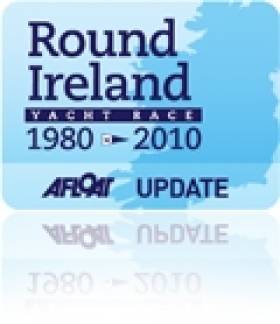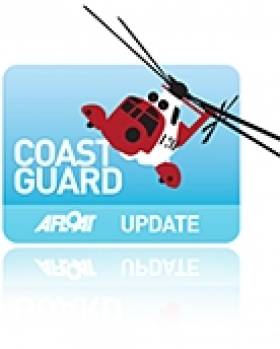Displaying items by tag: irish sea
DFDS Seaways Makes Final Irish Sea Departure
The ro-pax Dublin Seaways made a last crossing with a Saturday morning arrival at Birkenhead. After disembarking passengers, vehicles and freight traffic, the 21,856grt vessel immediately departed the Mersey for a short-term deployment on the company's North Sea Rosyth-Zeebrugge service.
Sistership, Liverpool Seaways also completed her last crossing to Birkenhead with an overnight Saturday sailing. This was the final scheduled sailing under DFDS Seaways ownership and marked the last foot-passenger crossing on the Liverpool route as rival operators P&O (Irish Sea) and Seatruck Ferries do not cater for this market.
The vessel returned to Dublin yesterday from Birkenhead; this was to facilitate the loading of drop-trailers and terminal based tugmasters (engine-driven truck/cabs) that tow unaccompanied trailers on the roll-on roll-off vessels. After a short turn around at the terminal, Liverpool Seaways departed Dublin, bound for Immingham. The UK east coast port is where DFDS operate an extensive freight route network across the North Sea.

The ro-pax Liverpool Seaways and freight-ferry Anglia Seaways berthed in Dublin Port yesterday prior to sailing away from the Irish Sea. Photo Jehan Ashmore / ShipSNAPS
In addition the 13,704grt Anglia Seaways also docked in Dublin yesterday from Heysham to perform similar duties like the Liverpool Seaways. Several hours later, the 114-trailer capacity vessel set a southbound course past The Muglins, bound for Avonmouth.
DFDS cited its decision to exit entirely from Irish Sea sector due to the sharp decline in the Irish and UK economies in 2008 and 2009. The company suffered continuous losses on its remaining routes and the issue of over-capacity, particularly on the north Irish Sea.
Only last December, the Danish owned shipping operator sold its other two Irish Sea routes to Stena Line in a £40m acquisition deal. This is all the more remarkable considering DFDS Seaways purchased the previous route operator, Norfolkline's Irish Sea division of their four routes and seven vessels, in July 2010.
The sale to Stena covered the three terminals used on the Belfast routes to Birkenhead and Heysham, which is another freight-only service. In addition the acquisition involved the sale of the South Korean built freight-ferries Hibernia Seaways and Scotia Seaways; like the Anglia Seaways they were all former Norfolkline / Maersk Line vessels.
Interestingly the acquisition is to include the purchase of the chartered 27,510grt ro-pax sisters Lagan Seaways and Mersey Seaways. When the Visentini built sisters were completed at the Italian shipyard, they were placed on the Belfast-Birkenhead route in 2005.
On 1 December Stena Line UK Ltd acquired DFDS Seaways Irish Sea Ferries Ltd (since renamed Stena Line Irish Ferries Ltd). Although the acquisition of SL ISF by Stena Line has been completed and DFDS no longer owns SL ISF, Stena Line await formal approval from the Irish competition authority and the UK's Office of Fair Trading (OFT) to integrate SL ISF into the wider Stena Line business.
In the meantime during this transitional period, it is business as usual for customers using the Belfast-Birkenhead and Belfast-Heysham routes. Online bookings continue to be accepted on www.dfdsseaways.com or tel: (01) 819 2999 and in the UK tel: 0871 230 033
Irish Ferries Voted ‘Best Ferry’ On the Double
At the second award ceremony, the company was again called to the podium to receive their 'Best Ferry' Company Award at the inaugural Irish Travel Awards, hosted by the Irish Travel Agents Association (ITAA). The award was voted by staff from travel agents throughout the country and the ceremony was attended by 500 guests at the Mansion House.
"Our staff can be doubly proud of their achievement – the first time that any ferry company has taken two top awards on the same day." commented Tony Kelly, Irish Ferries marketing director.
In both of the awards, the ferry company won against competition from UK and Continental ferry companies operating on services in and out of Ireland. Irish Ferries operate on two Irish Sea routes between Dublin-Holyhead and Rosslare-Pembroke Dock. In addition on the direct continental routes to France between Rosslare to Cherbourg and to Roscoff during the high season. For information about Irish Ferries logon to www.irishferries.com
Sadie Phelan is First Lady President of Wicklow Sailing Club
Round Ireland organiser, Wicklow Sailing Club has elected its first Lady President in the 60th anniversary year of the club.
Long time resident of Wicklow, Sadie Phelan, has been very involved in many roles in the club previously, having served as its Honorary Secretary for several years. Phelan also served as Wicklow SC ISORA representative as well as organising many fundraising and social events including the Round Ireland Prizegiving dinners.
This is a great honour for Sadie and her family and she will be a worthy ambassador for the members of WSC with her wide circle of sailing friends from both sides of the Irish Sea.
Foot-Passengers to Lose Liverpool Link
Closure of the Birkenhead route will see the withdrawal of the 21,856 grt Italian built sister-ships Dublin Seaways and Liverpool Seaways. There are a number of options being investigated as to where the ro-pax pair will go, they may be deployed on other DFDS Seaways routes or placed on a sale charter arrangement.
In addition the Danish-owned shipping company is to close the freight-only Dublin-Heysham route this month. The route is served by the 13,074 grt Anglia Seaways which has a 114-trailer capacity. The vessel is due to be transferred to the Baltic Sea, according to DFDS Seaways which also operates an extensive route network in the North Sea.
Unlike DFDS Seaways use of the double river-berth terminal at Birkenhead, on the Wirral Peninsula, P&O and Seatruck vessels navigate through locks into the extensive Liverpool Docks system. Interestingly all three operators use sister-ships with P&O running the Dutch built ro-pax's Norbank and Norbay and Seatruck Ferries Spanish built Clipper Pace and Clipper Pennant.
Discount Ferry Fare Scheme for Fireball Worlds in Sligo
Stena Line have confirmed their commitment to the discounted ferry fare scheme for entrants to the 2011 Fireball Worlds in Sligo Yacht Club from across the Irish Sea. Stena generously put in place a similar scheme for 2010 that allowed Irish Fireballers to get to the UK to collect the boats from Barbados and to contest the Fireball Europeans in the Czech Republic.
The scheme will only apply to the crossing of the Irish Sea, with the exception of the Fleetwood – Larne route, and regrettably will not apply to the routes from mainland Europe as Stena operates these in conjunction with other parties.
Access to the preferential fares will be via a dedicated website, using an event code and specific booking information all of which will be provided by the Irish Fireball Association once Stena Line have confirmed their fare structure for the 2011 season.
The website is www.stenaline.ie/event and the booking information will consist of specific words and a dedicated event number.
The only condition attached to this offer is that participants must be able to confirm their entry to the Worlds in documentary form at their ports of departure and arrival, otherwise additional charges will be levied.
Ferry-Fallout as DFDS Exit Irish Sea
The routes represented a fifth of the freight market and will result in the withdrawal of the twin 21,856grt passenger ferry (ro-pax) sisters, Dublin Viking and Liverpool Viking on the 7-hour Mersey route and the 13,000grt freighter Anglia Seaways on the route to Lancashire.
In recent years, new tonnage notably in the form of four freight-only newbuilds commissioned for Seatruck Ferries on their Warrenpoint-Heysham and Dublin-Liverpool routes has added to intense competition in a crowded north Irish Sea ferry-freight sector.
The process to purchase Norfolkline's Irish Sea operations by DFDS Seaways was finally completed in mid-summer of last year. The acquisition saw the Scandinavian newcomer take control of four routes between Birkenhead-Belfast / Dublin and the freight-only Heysham-Belfast / Dublin services and a fleet of seven vessels, four (ro-pax) ferries and three freight-only vessels.
DFDS Seaways latest decision is all the more dramatic as the company in early December then sold both Belfast routes to Birkenhead and Heysham to Stena Line. In addition the £40m acquisition included the sale of the chartered 27,510 ro-pax sisters Lagan Seaways and Mersey Seaways and the 13,000grt freighter half-sisters, Scotia Seaways and Hibernia Seaways. The deal is significant in that Stena will make an inaugural foothold on the Merseyside market.
With the sea-changes swirling in the Irish Sea market, the dominant player is with out doubt Stena Line. The ferry operator closed late last year the Larne-Fleetwood route and three vessels (for more information about those vessels click here) yet the inclusion of the former DFDS Belfast-Heysham route is closely similar with neighbouring ports and newer larger vessels.
The acquisition by Stena of the loss making routes from DFDS last month also coincided with a review to be conducted by the Danish companies remaining Dublin routes to Birkenhead and Heysham. The findings of that review were concluded with this months' decision by DFDS to close down the routes, marking the Scandinavians operators brief foray on the Irish Sea ferry scene.
Llandudno Lifeboat Celebrates 150 Years
The 30-strong crew of Llandudno RNLI are celebrating the 150th anniversary of their branch's founding.
"We are very proud to have reached this milestone," spokesman Alan Sharp told the Daily Post.
Since 1861 the Llandudno lifeboat has saved 550 lives from the Irish Sea off the coast of north Wales - many of them close to the town's renowned promenade.
The Daily Post has more on this story HERE.
Related Safety posts
RNLI Lifeboats in Ireland
Safety News
Rescue News from RNLI Lifeboats in Ireland
Coast Guard News from Ireland
Water Safety News from Ireland
Marine Casualty Investigation Board News
Marine Warnings
Single Handed Yachtsman Caught in Gale Calls for Assistance
The yacht owner had been seeking permission to come into the harbour seeking a safe haven as the weather conditions had begun to deteriorate, and the Coastguard were alerted by the harbour authorities. The harbour authorities expressed concern at the time about the condition of the vessel, a 22 foot, single masted, single person crewed vessel with a blue hull. The weather forecast was suggesting westerly winds of 21 to 29 knots at St Bees Head.
However by 5.40 am the yacht still endeavouring to keep out of the weather and he reported to the harbour authorities that he had taken a lot of water into his vessel. He was reassured by the authority that the Coastguard had been informed and the Whitehaven Coastguard Rescue Team were turned out. The Workington RNLI all weather lifeboat were also requested to launch.
By now the wind was gusting 42 knots and had turned to the north west which meant it was blowing straight into the harbour and causing the skipper major problems as the vessel was being thrown against the pier in the outer harbour. He was trapped in his cabin.
The Cumbria Coastguard Sector Manager was also alerted, and an ambulance called.
By 6.30 this morning the RNLI all weather boat had arrived and deploying their small 'Y' boat they sent two crew members across to the 'Tern' to get the skipper out from the badly flooded yacht. In the confined activities, one Coastguard Team Member was hit by the flailing mast and was taken to hospital. The skipper of the yacht was also taken to hospital suffering from hypothermia.
Paul Campbell, Watch Manager at Liverpool Coastguard said
"This was quite an awkward job in very difficult and deteriorating weather conditions. Fortunately the skipper is now safely in hospital and our own Coastguard Rescue Officer was given a check by the A&E department and discharged."
Proposed Irish Sea Conservation Zones
The area include the inshore waters of Merseyside, Lancashire and Cumbria and offshore waters of the Isle of Man, Wales, Northern Ireland and England. One of the zones is a 187 square km stretch of deep water between Northern Ireland and the Isle of Man.
In order to gain a greater understanding of the proposed zones, the report commissioned a Regional Stakeholder Group which drew from a diverse range of interests in the Irish Sea. Among the stakeholders included were the Royal Yachting Association, the fishing community and ports authorities. The review identified the size, shape and locations of the proposed 10 ten new Marine Conservation Zones. For the first time, the zones included inshore water of the Irish Sea project area as well as offshore.
"This is a real milestone for the project, with potential Marine Conservation Zones identified in both inshore and offshore waters", said Greg Whitfield, project manager at Irish Sea Conservation Zones.
"It is now really important that people take a look at the potential zones and give us their feedback on them. The better the information we have, the better the Marine Conservation Zones that are recommended by the regional stakeholder group will be."
Each of the marine conservation zones are designed to protect nationally important marine wildlife, habitats and geology. In addition they are designed to have the least impact possible on people's activities, but some restrictions will apply as the zones must meet guidelines for protecting species and habitats.
Members of the public are being invited to participate and will be considered as the second project continues to refine its proposals. The report is only a snapshot of the work so far. It does not contain concrete recommendations for the locations of Marine Conservation Zones (MCZ) in the Irish Sea, and the potential zones shown in the report are described as tentative and liable to change.
The Irish Sea Conservation Zone project will be releasing a third report before the Regional Stakeholder Group finalises its recommendations. The reports are delivered to the Science Advisory Panel. The independent body is comprised of expert scientists whose main role is to evaluate the potential of MCZs against ecological criteria.
The third progress report will be made available in February 2011. Its final recommendations will then be presented to the UK government in June. Following that a formal public consultation on the proposed MCZs are to take place in late 2011 and early 2012.
For information on the Second Progress Report including feedback forms can be downloaded from HERE or by calling 00 44 (0)1925 813 200
Irish Sea Newcomer Sells Routes To Stena
The sale covers the routes between Belfast and Birkenhead (Liverpool) and Belfast-Heysham. Operating on the northern Irish Sea routes are two 13,000 gross tonnes Japanese built freight ro-ro ferries sisters Hibernia Seaways and Scotia Seaways in addition to two chartered ro-pax vessels as part of the transaction.
Niels Smedegaard, CEO of DFDS, said: "The Irish routes we took over in conjunction with the purchase of Norfolkline have, in spite of the recent impressive efforts by everyone employed on the routes, in the last two years lost more than thirty million euros. Given the depressed economies a turnaround of the activities, without structural solutions, is not realistic. On this basis, we have decided to scale back our activities and sell the two routes to and from Belfast."
In the deal Stena Line, the Swedish owner will also take control of port terminals in Belfast, Birkenhead and Heysham. The majority of shore-based staff at these port terminals will be transferred to Stena, maintaining their current conditions.
DFDS and Stena Line will share staff at these locations during an agreed transitional period at the end of which DFDS will establish their own agency operations at Birkenhead and Heysham.
The new arrangement will see DFDS focusing on its other services between Dublin to Birkenhead (which includes passengers) and from Dublin to Heysham. Italian built sisters ro-pax sisters Liverpool Seaways and Dublin Seaways currently operate on the Dublin-Birkenhead route and the 120-trailer freight-ferry, Anglia Seaways maintains serving the Heysham route. Operations at the Dublin Port terminal are not affected by this transaction.
DFDS will continue to review their strategic and operations routes in Dublin, which is expected to be completed in the first quarter of 2011. The Danish owned shipping and logistics transportation company operate an extensive route network throughout the Irish Sea, North Sea and Scandinavia.




































































